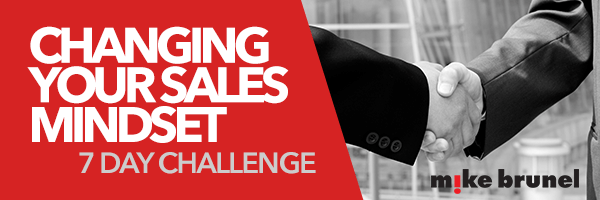by Mike Brunel | Sep 26, 2022 | Negotiation, Strategy
Do you know the difference between a small sale and a large Sale
An excellent book that I have tucked away in my library is called Spin Selling by Neil Rackman.
In Neil’s book, he maintains that there is a difference between a small sale and a large sale and different philosophies are used for both. I consult with a lot of commission-based salespeople, including real estate agents and media salespeople. Many of their transactions are large. Knowing the difference between a big sale and not so big sale is handy to know for these salespeople.
If you are able to know the difference between a large sale and a small sale you might just be able to save a lot of time when you go to prospect.
So what is the difference?
How does that relate to your long-term success?
If you can grasp this idea you will be able to avoid all those frustrating “no calls” you keep making and begin to focus on the calls that do matter.
The general rule for small sales is the one from Neil’s book.
He is sitting in an airport waiting for a connecting flight; he was browsing in a store and spotted one of those multipurpose knives, like the Swiss Army knife, the price of $15.
Within 2 seconds of seeing it, he bought it and his immediate need was satisfied. To him, it was what I call a no-decision decision.
Now, what about a bigger sale? Let’s take another scenario, you are meeting your client for the first time, and potentially that client could invest with you several thousand dollars worth of products or services.
Are you going to get him or her to buy on the first call?
The best way to approach the larger sale is to expect that it may take a little longer. They simply have different needs than smaller sales.
Here a sure-fire way to make sure that you do know the difference:
- A larger sale will contain more than one decision maker
- A larger sale involves asking more specific questions about their problems and moving them up to solutions.
- Larger clients tend to take a more rational approach to decision-making than smaller clients.
Do this on a regular basis and monitor what are your small sales and your larger sales.
One action you can take straight away is to write down all your larger clients based on spend and see if this does stack up against the criteria above.
List all your larger clients in a notebook and begin to ask questions to discover their needs over time.
Have great fun selling your stuff.
Mike

PLUS: WHENEVER YOU’RE READY…
Here are 4 ways I can help you make more sales in your business – whether your business is big or small.
1. Want to become a Sales Mindset Blueprint Member? Every month you get access to an exclusive coaching session with me as well as full access to my sales programme. Get the deets here.
2. Try the new ‘7 Days to Sales Success’ framework. Make more sales in 7 days. The framework of everything you need to get started in making more sales in your business. The Sales Success Framework is based on a simple 7-day challenge. Click here to find out how you can grow your business by making more sales.
3. Join our private Facebook group – The Sales Mindset Inner Circle. Get all the latest up-to-date sales ideas. Every week we do Facebook Live updates on all things sales. Tips, ideas, free coaching, and much more. Join me by clicking here
4. Work with me one-on-one.If you’re a business owner, small or large or in professional services you might just be a few strategies, tactics and tools away from doubling your lead flow, revenue and impact. Jump on a FREE 15-minute brainstorm call with me by clicking here.
Good Selling
by Mike Brunel | Sep 20, 2022 | Sales, Uncategorized

All Systems Go- The Journey Begins.
In my last blog, I talked about Selling what you can’t see, and how Doug Gold, my business partner and previous owner of the More FM network came up with an idea to sell media inventory that went on to dominate the direct media sales world for well over 20 years.
After his first launch of the Gold Key Programme in Wellington New Zealand, we knew we were on to something special. The product and the problem had changed, as had our approach. Spots and Dot selling were out, and membership was in.
Looking back, it was revolutionary, no one was selling media this way. Subscription-based selling had been around for 50 years, now everyone thinks it’s the ‘new new thing”. All we did was apply that model to selling inventory on media companies.
I was initially invited into the company as a consultant, but when I saw what Doug had created, it was as if a light went on, I knew that if I could build a sales system that could duplicate the concept he was presenting in that room in a hotel in Wellington, I could leverage it.
I sat in on all the presentations as an observer for a week, and watched how all the salespeople sold. I monitored how the clients bought. I recorded the presenter’s speeches and analyzed all the ways that they presented the product. Then I went away and created the first Image Plus programme. A predictable lead generation product that would pretty much guarantee a result. Then I took it to my partner who had just gone to Australia to set up our consultancy services, the wonderful Mr Duffy.
I think we are onto something”
Brian Duffy trusted me to package it up and take it to a client of his in Hobart, Tasmania. I went in and said, “If you follow this system, I can write a million dollars in revenue for you guaranteed” We launched the program and generated $1 million in four days. In today’s money that’s around $4.5 million. Our cut was a commission fee on the revenue generated.
Boom! We were smoking! I remember at the time watching Brian writing on a small business card how many we had sold each session, after the third session, he came over to me and said. ” I think we are onto something, I count thirty gone of our allocated 100 memberships and it’s only day one, I’m excited”!
Success is Natural
People look at that success and assume it takes a team of natural salespeople to develop and execute such an idea; they don’t believe they can do it themselves. Granted, I have a passion for business, but I came from a very small country where nobody was doing this sort of thing. We had some brave, courageous risk-takers as our first clients.
The early adopters in Hobart said, “Yeah, we’ll give it a go” and we were grateful. You may not think you are a salesperson, but if you are in any kind of business, you are just as much a salesperson as Doug, Brian, and me, and you can find clients willing to take the leap with you.
Practice Makes Perfect.
Of course, the journey that NRS Media took has not always been easy. I remember one time I was presenting near Lincoln, Nebraska, expecting 300 people to attend our seminar. Five turned up.
When something like that happens, all you want to do is hide. If you could, you would actually crawl in a hole, pull the cover over the top, and not come back out. Sometimes it seemed like I was on my own and the rebuffs were never-ending. I had a bit of natural resilience, but it really is a lonely place, selling in America is a tough gig. Many people avoid sales because they fear rejection.
Sell something you Believe in.
What you have to remember, though, is that if you are doing something you love, selling something you believe in, then you are performing a service. You are not ripping off the customer, or doing the wrong thing by them. Someone is going to buy it from you. As long as you remember that, you can lift your head back up and start again.
Take Flight from Fright
You should realize that most people don’t take naturally to selling. I often see people so frozen they’re afraid to pick up the phone. Folks freeze with fear, unable to make the call. They’re paralyzed with fright. Excuse my language, but they’re sh*$$!ng themselves because they’re so afraid of the reaction. Many people find selling terrifying; it’s a natural human reaction. The thing is, this fear comes through in their work and makes them less effective.
If you own a product, service, or business, you have to sell. If you’re passionate, believe in that product, and know that your customer should have it, then don’t be afraid to go and present it.
Try not to think of it as asking a yes-or-no question. Instead, picture yourself helping the customer through the decision-making process. Simultaneously, you come to comprehend their needs, wants, and desires. If you can honestly say, “Look, this is my product. I believe in it. I think it’s right for you,” and you come from a position of integrity people will respond. All it takes is a shift in perspective. Stop thinking, “I’m not in sales.” Reframe that thought.
Call it Something Else.
Call it something else. Recognize it for the relationship-building process it really is. Changing my mindset has helped me personally banish the fear of rejection. At first, I tried half-heartedly and then gave up, just like anyone else. I realized, though, that if I didn’t change the way I thought about sales, I was going to lose. Today, I help salespeople change their frame of mind so they’re working steadily toward a reward rather than flailing about trying to avoid failure.
I remember working with a new salesperson on this issue. He was seriously afraid of going out and talking to people, so we gave him some new words to practice just before the sales call.
We asked him to say “relationship building” instead of “selling” in his mind and we saw right away the fresh connections he was making. His new vocabulary changed his mindset. He was much more comfortable—and successful—in his calls after he implemented this simple tool.
Successful sales also mean maintaining relationships with clients over a long time period without getting the payoff of a “yes.” In the early days of my business, I remember approaching clients who would say no three, four, or five times. I considered that a failure. I thought, “Well, I just can’t do it.”
What did I learn?
Successful sales also mean maintaining relationships with clients over a long time period without getting the payoff of a “yes.” In the early days of my business, I remember approaching clients who would say no three, four, or five times. I considered that a failure. I thought, “Well, I just can’t-do it.”
What I discovered, though, was that I had to see rejection as a temporary setback and make plans to move on. I had to say to myself, “Okay, Mike, what did you learn and what could you do differently? Could you apply a different approach to that problem? Let’s try it and see what happens then.”
Selling is easy “it’s just how you think about it”
Mike

by Mike Brunel | Sep 12, 2022 | Strategy

When I came into media, my main challenge was to sell something invisible. I learned that people buy ideas more than things. They buy concepts, promotions, and methods for getting people into their stores.
In the early 90s, the media industry in New Zealand was entering deregulation. The government had decided to “open up the airwaves” and issue new opportunities for starting radio/media companies. Doug Gold, the original owner of More FM (now Mediaworks) recognized an opening when he saw one. He obtained several licenses to operate new radio stations in cities and towns all over the country.
Culture First- The Rest Follows.
Doug had created an amazing culture and fun way of doing business at media companies he had previously managed. Once word got around that he was starting a new venture, former staff flocked to be on the journey with him. Some would not receive any income for several months, but they trusted him and believed his latest project would be special.
The challenge for the new media enterprise was that they would be working in one of the most competitive categories in the world. Media bleeds money like a wounded bull, and it is riddled with failures, obnoxious personalities, and owners with huge egos.
Doug’s personality, on the other hand, was just the opposite. He had courage, belief, and an unbending single-mindedness; the usual hurdles would not present a problem for him.
Starting on an unusual note, Doug launched his new company with a product called The Gold Key program. When Doug had researched the best way to enter the advertising market, he sought advice from hundreds of clients.
Needs Matter
He asked questions about everything. He asked what they wanted in their advertising, examined their paths in sales and marketing and observed their needs.
He knew it would be much easier—and less daunting—to ask for someone’s business if he already knew what that prospective customer needed. He was involved in every aspect of the business, down to the formatting of his stations’ programmes.
One of the insights Doug gained from his research was that his advertising clients were sick of just buying “spots and dots.” They wanted to belong to a group, a modern-day tribe of sorts.
Doug also discovered that clients needed to advertise and promote themselves continually. Constant exposure paid off and made advertising more affordable to small-to-medium companies. Many big companies already supported their products and services this way, and it worked well.
They were the big guys, though; they could afford it; with their resources, they could simply outshout anyone else’s marketing. Now even the little guy could compete.
When it has gone, it’s gone.
Most media companies generate their income through advertising. It’s their inventory, just like all the stock in a retail store. The only difference is if that “inventory” is not sold that minute, hour, or day, then the opportunity at that moment is gone forever. Once the advertisement due to be sold at midday is NOT sold, it’s gone. The use-by date has expired.
The American Express of Media
Doug understood his clients and the market, so he created a membership program. He asked his clients to commit to him for twelve months. Each advertiser would receive a monthly allocation of commercials; in return, they received benefits like travel deals, access to unsold airtime, and upgrades to better commercial times. While perks like this are common today, they were a novelty in media back then.
What is often referred to as “one-to-many” selling works best in a seminar situation. Every client attending Doug’s seminar received valuable information on advertising and promoting their business.
Any advertiser who agreed to membership also earned a free chance at winning a brand-new BMW. This was unheard of at the time. It was mind-blowing, really, and took the market by storm.
In year one, Doug and his amazing team sold $1.2 million in revenue before they even opened the media company and before one song was played. In today’s dollars, that would be around $4.6 million. What sold it?
Creating a Selling System.
The key was a combination of belief, systems, a great team, and innovation. Doug generated hundreds of memberships and improved his already stellar reputation.
Over several years, Doug’s product became known as the Image Plus program. With my other founding partner, Brian Duffy, driving the helm and me writing all the sales manuals and implementing the training programmes, we then took on the world.
These days, one product is part of a suite that my old company NRS Media (Since sold), sells to over 400 media companies in twenty-three countries, in eleven languages. In the past 25 years, the Image Plus program has generated over $1 billion in annual revenue for its clients.
The start of something special. These days you would have called it a start-up. The only difference is that over the next 20 years, NRS Media never borrowed a cent, zip, or zero. All self-funding by its owners.
An idea is tested, refined, and then proved.
Why did it sell? The market was ready for it. The media companies’ advertisers wanted to buy it, and in the end, 150,0,000 of them bought it every year for 15 years.
And now there is more to come, something new for media companies.
Keep you posted.
Mike
PLUS: WHENEVER YOU’RE READY…
Here are 3 ways I can help you make more sales in your business – whether your business is big or small.
1. Try the new 7 Days to Sales Success Framework.
Make More Sales in 7 days. The framework of everything you need to start making more sales in your business. The Sales Success Framework is based on a simple 7-day challenge. Click here to find out how you can grow your business by making more sales.
2. Join our Private Facebook Group – The Salesmindset Inner Circle. Get all the latest up-to-date sales ideas.
Every week we do Facebook Live updates on all things sales. Tips, ideas, free coaching, and much more. Join me by clicking here.
3. Work with me One-on-One.
If you’re a business owner, small or large or in professional services, you might just be a few strategies, tactics and tools away from doubling your lead flow, revenue and impact. Jump on a FREE 15-minute Brainstorm call with me by clicking here.
by Mike Brunel | Sep 7, 2022 | Sales

I understand people’s reluctance to think of themselves as salespeople. I had a love/hate relationship with sales myself when I was younger. I grew up on a small farm on the coast of New Zealand, a place I loved.
My father looked after the farm after his four brothers went to World War II. From the age of 15, he worked on that farm, developed it, and expanded it. By the time he was 35, it was clear that some of his brothers would never let him buy it, though; they wanted their share. In the end, sadly, my father had to sell.
Overnight, we moved to a new town and Dad travelled all the time for work. I didn’t know anybody at my new school. The new kid always gets bullied and picked on, and I was no exception.
I wasn’t happy, but I learned to adapt. I was forced to find a way to meet new people and create new friendships. That was probably the real start of my sales career.
I may have been a hesitant salesperson at age seven, but I was already learning how to open up relationships with others.
Life Lessons Learnt.
As a young man, I left a small town in New Zealand to live in Sydney, Australia. Perhaps 15,000 people lived in my hometown and at 18, I moved to a city that housed four million.
At 18 I was reasonably good at rugby—a national obsession in New Zealand—so I got to play in Sydney, where I also got a job selling stationery to newsagents. Every Sunday evening I would put all the goods that I wanted to sell into a big blue bag. On Monday morning, I’d throw it in the back of the car and drive from the suburbs into the city of Sydney.
I’d park my car and walk around, calling on my clients and also knocking on the odd door. I sold everything—rubber bands, ballpoint pens, books, and stationery—out of that big blue bag. I practised all the skills needed to be a strong salesperson. I was perfecting my craft.
On the Move
When I later gave up on sports and moved to London, I could not find a sales job, or so I thought. After six months spent cleaning carpets in upscale homes, I was offered an estimator’s position with the cleaning company.
I was a salesperson once again. There I was, in my early 20s, driving all over London, quoting jobs in the most luxurious homes imaginable. I met some amazing people and learned to negotiate and sell on a whole new level.
Sadly, I had to return home and ended up bunking with my brother. After several weeks of moping around his house, I let him convince me to apply for an advertising executive position for a local radio station.
I borrowed his suit and shoes for the interview. The suit was a little tight and the shoes a lot. I remember trying not to let the suit sleeve stay fixed on my elbow when I shook the interviewer’s hand.
Guess what? I got the job.
I had never sold advertising before, but I was willing to learn. I sold ideas to advertisers and small businesses for the next few years. I saw firsthand how small businesses ticked. I brought in entertainers to open stores, launched products, and ran promotions. I did every type of campaign that could be done.
The businesses loved it and I did too. The job taught me that I had to stop selling the air time itself and start selling the result of a promotion or event.
Eventually, I was recruited to manage a sales team for another media company a few hundred miles away.
There I met my first true mentor, Brian Duffy, who taught me to look at sales and management, and myself, differently.
Brian coached me to be a good manager and a good person. Oh, I made mistakes, but his guidance and support helped form beliefs that I carry with me today.
Mentors pave the way.
Mentors pave the way, and Brian mentored me long-term, into my next job and eventually into NRS Media. Brian’s guidance led me to media broking, where I met mountaineer Rob Hall, another great mentor.
As much as I enjoyed media broking, though—the perks were considerable, including good food, lots of socializing, and free stuff on top of excellent money—the seductive sheen soon wore thin for me.
I knew I should be doing something else, but I didn’t know what it was. I was not happy. I thought that maybe it was time to take more risks in my life; I knew something was missing.
I was looking for something to fill that space and then one day I got a phone call that would change my life forever. Opportunities often come to you unexpectedly if you make room for them. It was Brian again. “Mike, let’s meet for coffee,” he said, “I have an idea.”
Even today, I can see both of us sitting there in the café. He says, “Look, I’m moving to Australia, but I have clients here I want you to look after.
Join me and my partner in this future opportunity, but you’ll have to pay to get in.” It cost $5,000 to get into the business. It was a lot of money, but it was taken as a show of commitment.
They wanted me, but they wanted me to pay to get in? Was it worth the risk?
The partner’s name was Doug Gold. He had started a new media company called More FM. He also had a consultancy company with Brian that was called Persuaders Concepts. (Can you believe that name)
His More FM Network quickly became the second biggest media network in the southern hemisphere. It is now known as Mediaworks. Doug’s unique ideas influenced industries across the globe. I didn’t know that then, but I took a leap anyway and said “yes.”
Over the next 20 years, that yes became NRS Media.
A valuable lesson I learned is that opportunities do not come when you want them to…. be scared and afraid is part of the ‘doing’
Next week I will talk about how NRS Media became the powerhouse in media sales globally, with no start-up money, no investors, just luck, timing, passion and a great team of people.
Until then
Good selling
Mike.
P. S Tired of missing out on those sales and not knowing why! Try our FREE CHANGING YOUR SALES MINDSET -7 DAY CHALLENGE






